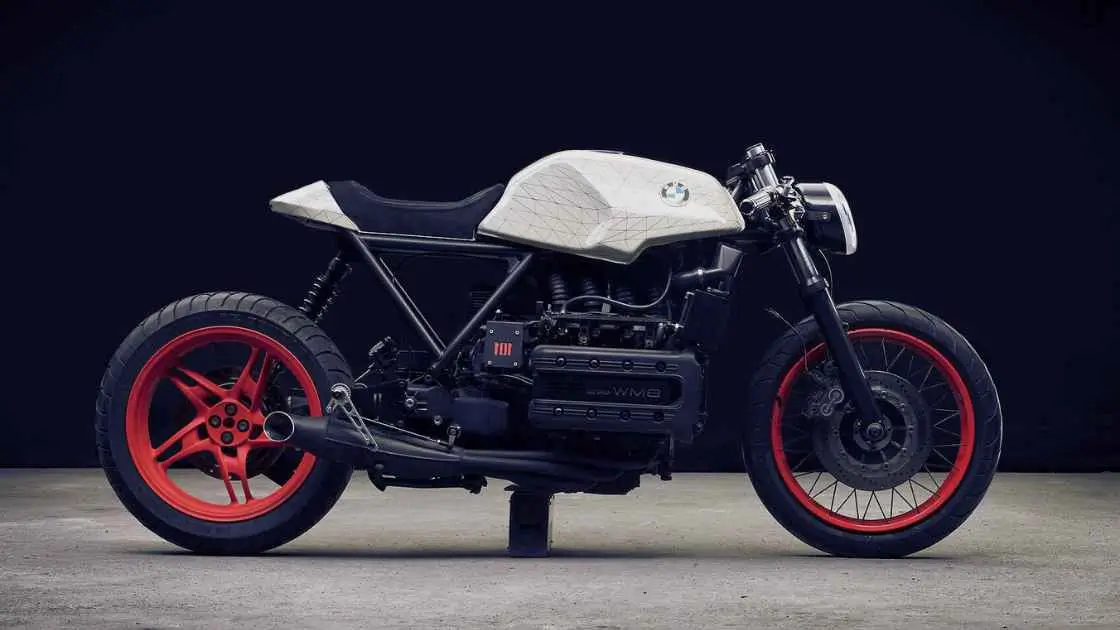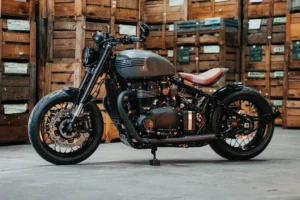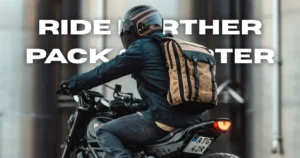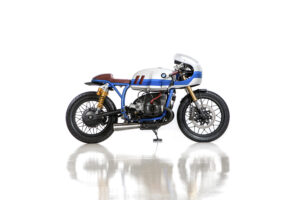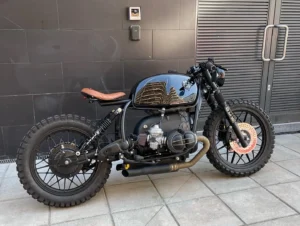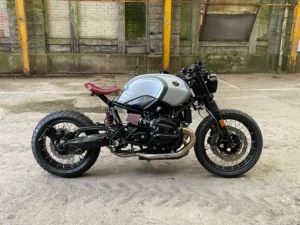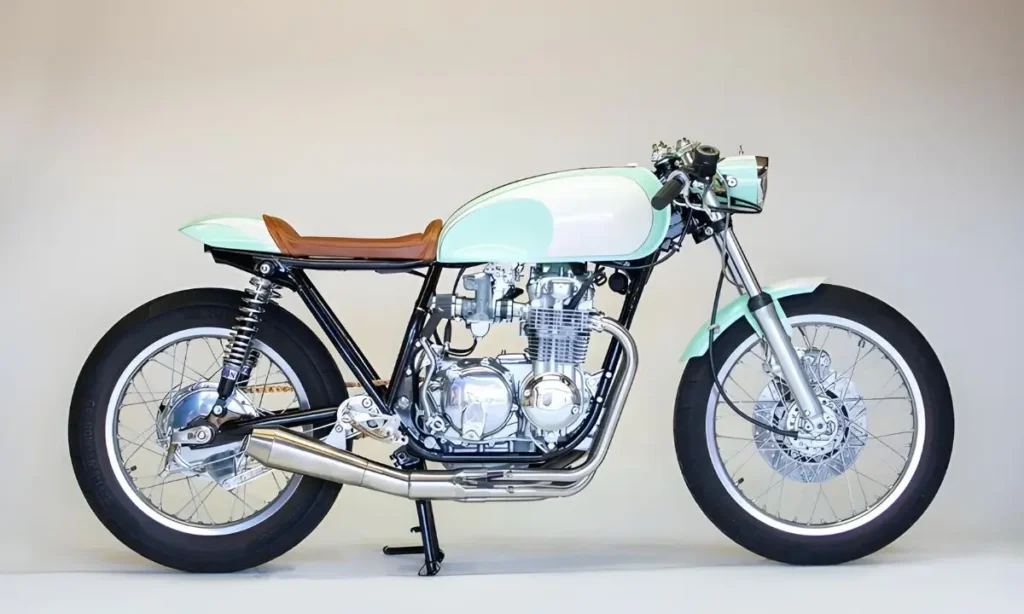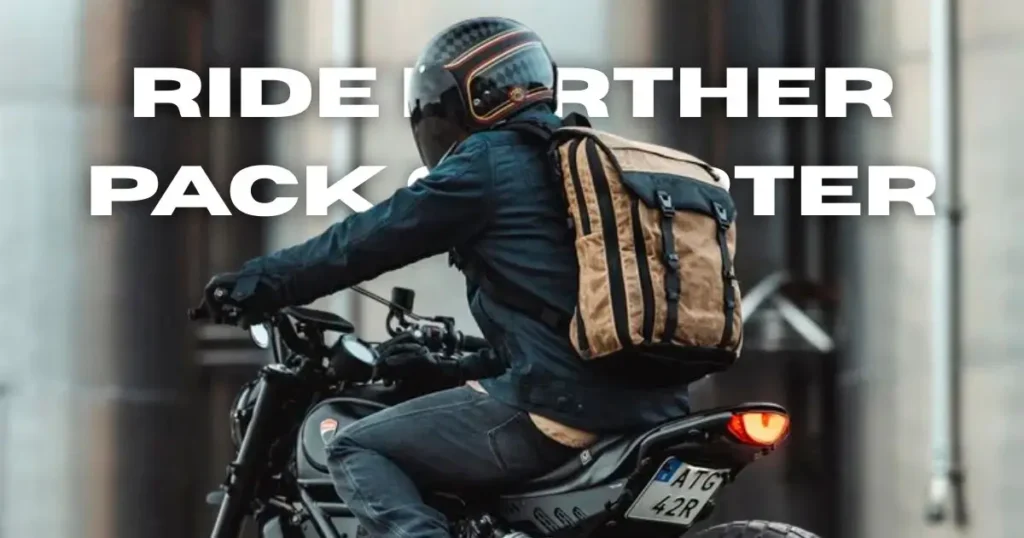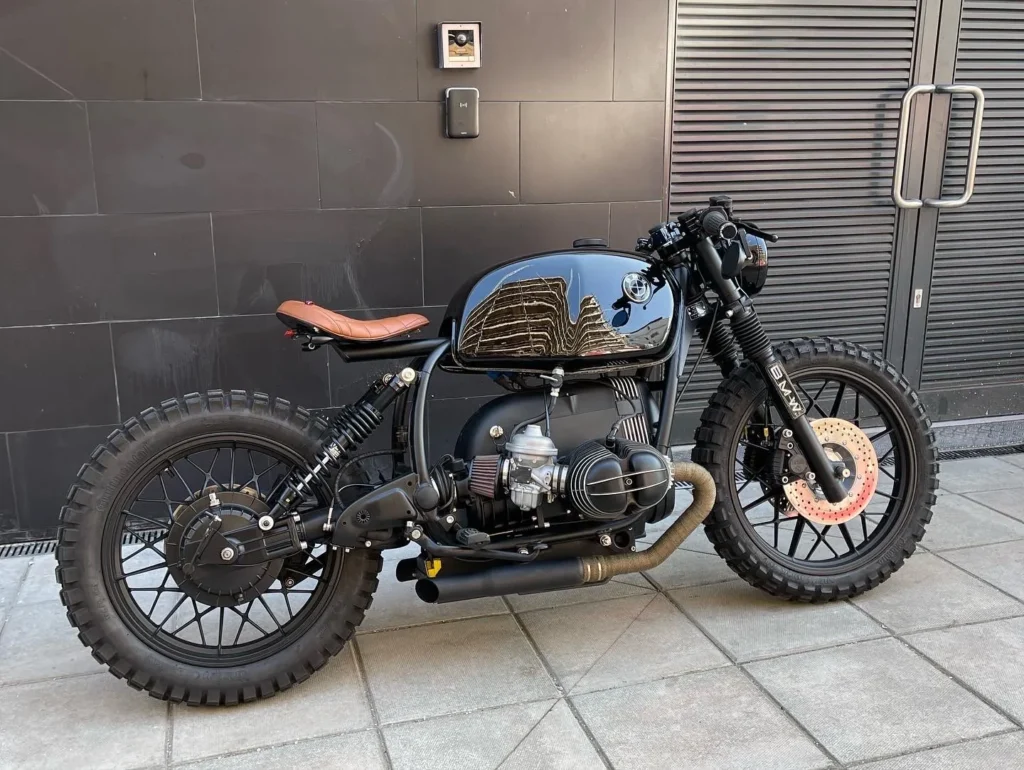Table of Contents
ToggleSo, you’re thinking about the 1985 BMW K100 Cafe Racer. Whether you’re deep into cafe racer culture or just starting out, the K100 is hard to miss. In the past, BMW was known for their R-series, which were air-cooled. But the K-series was a big change, and the 1985 model stands out for many reasons.
So, why the K100? It wasn’t just another bike; it marked BMW’s move into the modern era. The “Flying Brick” engine—named for its boxy design—was new and reliable. But it wasn’t just about reliability. Something about the K100 makes it the perfect base for a cafe racer. Maybe it’s the strong but simple frame or the satisfying hum of the engine. Whatever it is, the 1985 BMW K100 Cafe Racer has become a favorite among enthusiasts.
Technical Specifications of the 1985 BMW K100 Cafe Racer
Understanding the details of the 1985 BMW K100 Cafe Racer is key when starting a custom project. Here’s a clear breakdown:
Engine
- Type: Inline-four, liquid-cooled
- Displacement: 987cc
- Power Output: 90 horsepower at 8,000 RPM
- Torque: 63 lb-ft (86 Nm) at 6,000 RPM
- Bore x Stroke: 67 mm x 70 mm
- Compression Ratio: 10.2:1
- Fuel System: Bosch LE-Jetronic fuel injection
- Cooling System: Liquid-cooled
- Ignition: Digital electronic ignition
- Nickname: “Flying Brick”
Transmission
- Gearbox: 5-speed manual transmission (some models have 6-speed)
- Final Drive: Shaft drive
- Clutch: Wet, multi-plate
Chassis
- Frame: Steel tubular frame
- Front Suspension: Telescopic fork, non-adjustable
- Rear Suspension: Single-sided swingarm with monoshock, adjustable preload
- Front Brakes: Dual 285 mm discs with 2-piston calipers
- Rear Brakes: Single 285 mm disc with 2-piston caliper
Wheels and Tires
- Front Wheel: 18-inch cast aluminum
- Rear Wheel: 17-inch cast aluminum
- Front Tire: 100/90-18
- Rear Tire: 130/90-17
Dimensions
- Wheelbase: 1,515 mm (59.6 inches)
- Overall Length: 2,200 mm (86.6 inches)
- Overall Width: 810 mm (31.9 inches)
- Seat Height: 800 mm (31.5 inches)
- Dry Weight: About 530 lbs (240 kg)
- Fuel Tank Capacity: 5.8 gallons (22 liters)
Performance
- Top Speed: About 137 mph (220 km/h)
- 0-60 mph (0-100 km/h): Around 4.5 seconds
- Fuel Consumption: About 45-50 mpg (5.0-5.3 liters/100 km)
Electronics
- Instrumentation: Analog speedometer and tachometer with digital trip meter and odometer
- Electrical System: 12V, with a 20Ah battery
- Lighting: Halogen headlight, incandescent taillight
Miscellaneous
- Available Colors: Black, red, silver, blue, and others
- Production Years: 1983-1992 (K100 series)
These specs show why the [1985 BMW K100] is a popular choice for cafe racer builds. It has a strong frame, a reliable engine, and plenty of power.
The Cafe Racer Culture
So, what’s the deal with cafe racers? If you’re new, here’s a quick intro.
Cafe racers started in the UK in the 1960s. Young riders stripped down their bikes, taking off anything that didn’t help them go faster. They’d race from one cafe to another, which is how the name came about. The focus was on speed, style, and a bit of rebellion—traits that still define the culture today.
At first, the 1985 BMW K100 Cafe Racer might seem like an odd choice. BMWs are known for touring, not street racing. But that’s what makes the K100 cool. It’s unexpected—a bike built for comfort turned into a fast, sleek racer.
The K100’s design fits the cafe racer look. The frame is simple and easy to strip down. And the “Flying Brick” engine is a statement by itself. When you ride a 1985 BMW K100 Cafe Racer, you’re not just part of the culture—you’re changing it.
READ MORE: BMW K100 Cafe Racer: History, Customization Tips, Iconic Builds, and Maintenance Insights
Customizing a 1985 BMW K100 into a Cafe Racer
Now the fun begins. Turning a 1985 BMW K100 into a cafe racer isn’t easy, but it’s worth it. Let’s break it down into steps.
Initial Considerations
Before you start, think about your goals. Are you going for a minimalist look or something with more flair? What’s your budget? Do you have the tools and space to work on your bike? These questions will help guide your project.
Start by planning your build. Look at other K100 cafe racers to see what’s possible. Check out forums, blogs, and YouTube channels where other builders share their experiences. This will give you a clear idea of what you can do with your 1985 BMW K100 Cafe Racer.
Stripping Down
The first step is to strip the bike to its basics. Remove the stock fairings, side panels, and anything else you don’t need. With the 1985 BMW K100 Cafe Racer, this is easy. Start by removing the bulky fairings and the old-school dashboard. You’ll also want to replace the stock seat—it’s not very stylish.
Once stripped down, you’ll see the bike’s potential. The K100’s frame is simple and elegant—perfect for a cafe racer. This is your blank canvas, ready to be customized.
Frame Modifications
A cafe racer’s shape is long, low, and lean. To get this look with your 1985 BMW K100 Cafe Racer, you’ll need to modify the frame.
Start by cutting the rear subframe. You can get creative here. Some builders go for a straight-cut rear frame, while others prefer a looped design. The goal is to create a clean line from the tank to the tail. After cutting, weld on a new subframe to support your cafe racer seat.
Speaking of seats, this is a key part of your build. A cafe racer seat is narrow, flat, and sleek—the opposite of the stock K100 seat. You can buy a pre-made seat or make one if you’re good with upholstery. Make sure it fits the new frame and matches the bike’s look.
Engine and Performance Upgrades
Now, let’s talk about performance. The 1985 BMW K100 Cafe Racer is solid, but some upgrades can make it even better.
Start with the exhaust. The stock exhaust is big and heavy—not ideal for a cafe racer. Replace it with a lighter, more streamlined exhaust. This will boost performance and give your bike a deep, throaty sound that every cafe racer should have. There are many aftermarket options, or you can go custom if you want something unique.
Next, think about upgrading the air intake and tuning the engine. The K100 is known for reliability, but with some tweaks, you can get more horsepower. A popular upgrade is pod filters, which look cool and improve airflow to the engine. Combine this with a custom tune, and you’ll see a nice performance boost.
Suspension and Wheels
Handling is key for a cafe racer, and the stock suspension on the K100 can be improved. Upgrading the front forks and rear shocks will make your 1985 BMW K100 Cafe Racer feel more responsive and sporty. You might also lower the bike a bit to get that classic cafe racer stance.
Wheels are another big factor. The stock wheels are sturdy but not very stylish. Many builders choose spoked wheels for a more vintage look. If you stick with the original wheels, consider painting them or adding custom rims to enhance the look.
Electronics
Electronics can be tricky when customizing a 1985 BMW K100 Cafe Racer. The K100’s wiring is complex, so simplifying it is a must. Start by replacing the bulky gauges with something more minimal. A small, round speedometer and a few indicator lights are all you need.
Rewiring the bike is also a good idea, especially if you’re adding new lights or indicators. Consider a modern wiring harness designed for custom builds. This will make the bike easier to work on and more reliable.
Finishing Touches
Finally, it’s time to add the finishing touches that will make your 1985 BMW K100 Cafe Racer truly yours. Paint is one of the most important parts of any custom build, so take your time choosing the right color. Many builders go for classic black or metallic shades, but don’t be afraid to try something bold. This is your bike—make it reflect your personality.
Decals, badges, and other small details can also add small but meaningful touches to the overall look of your bike. Adding personal details to your 1985 BMW K100 Cafe Racer will ensure it stands out. Consider custom badges, engraved with your initials or a unique design. Don’t forget about grips, mirrors, and other small features that will complete the look.
Remember, the goal is to create a bike that not only performs well but also catches eyes. Every detail matters, and the time you invest in these final touches will pay off when you’re on the road.
Notable BMW K100 Cafe Racer Builds
As you explore the world of BMW K100 cafe racers, you’ll find some truly inspiring builds. Each one offers a unique take on what a 1985 BMW K100 Cafe Racer can be, showing just how versatile this bike is.
For example, the K101 by Impuls, a custom shop in Munich, is a perfect example of how the K100’s “Flying Brick” engine can be part of a sleek, modern design. The team at Impuls worked with artists to create a motorcycle that’s as much art as it is a machine. With custom parts like a one-off tail section, subframe, and air intake, the K101 pushes the limits of what you can do with a BMW K100.
Another standout is the K100RT Cafe Racer by Black Shuck Kustom. This bike started as a touring model, but after major modifications, it became a lean, mean cafe racer. With its Graphite color scheme, red accents, and custom exhaust, this K100RT blends vintage style with modern performance. It shows that even a bike built for long rides can become a street-ready racer.
These are just a couple of examples, but there are countless other K100 builds out there. Each one shows how you can take the basic structure of a 1985 BMW K100 Cafe Racer and turn it into something unique. Whether you’re looking for inspiration or just want to see what’s possible, these builds are a great starting point.
Common Challenges and Solutions
Let’s be honest—building a 1985 BMW K100 Cafe Racer isn’t always easy. There will be challenges along the way, but each one has a solution.
One common issue is the bike’s electrical system. The K100 was one of BMW’s first bikes with electronic fuel injection, which means the wiring can be tricky. Simplifying the wiring harness is essential if you want to avoid electrical problems later. A modern wiring harness made for custom builds can save you a lot of headaches.
Another challenge is finding the right parts. The K100 is over 30 years old, so some parts can be hard to find. Thankfully, there are many aftermarket suppliers who specialize in older BMWs. Websites, forums, and online marketplaces are great for tracking down everything from brake calipers to custom exhausts.
Finally, one of the biggest challenges may be your own patience. Building a 1985 BMW K100 Cafe Racer is a labor of love, and it can take time to get everything just right. Don’t rush the process. Take your time, enjoy the build, and remember that the journey is just as important as the destination.
Costs Involved in Building a 1985 BMW K100 Cafe Racer
Building a 1985 BMW K100 Cafe Racer is a rewarding project, but it’s important to understand the potential costs. Here’s an estimate of what you might spend:
Initial Purchase of the Bike:
- Price Range: $2,000 – $5,000
- Factors: Condition, mileage, location, and whether the bike is partially customized.
- Tip: Look for bikes that are mechanically sound but may have cosmetic issues; these often offer the best value for a custom project.
Parts and Modifications:
- Custom Exhaust: $300 – $1,000
- Details: A good exhaust system is crucial for both performance and looks. Custom options vary widely based on material and brand.
- Suspension Upgrades: $400 – $1,500
- Details: Upgrading the front forks and rear shocks will greatly improve ride quality and handling.
- Cafe Racer Seat: $100 – $400
- Details: A key element of the cafe racer look. Prices vary based on material and customization level.
- Wheels (Spoked or Custom Rims): $500 – $1,000
- Details: While stock wheels are functional, many builders opt for spoked wheels for a vintage appearance.
- Electronics (e.g., new gauges, wiring harness): $200 – $600
- Details: Simplifying the electrical system can improve performance and give the bike a cleaner look.
Labor Costs (if not doing the work yourself):
- Hourly Rates: $50 – $150 per hour
- Estimated Total Labor Costs: $1,000 – $5,000
- Details: Labor costs vary depending on the complexity of modifications and the mechanic’s expertise.
Tools and Equipment:
- Basic Tools: $100 – $500
- Details: If you don’t have basic tools, this upfront investment will be useful for the entire project.
- Specialized Tools (e.g., welding equipment, painting tools): $500 – $2,000
- Details: Depending on the modifications, you may need specialized tools. Consider renting or borrowing to save costs.
Paint and Finishing:
- Custom Paint Job: $500 – $2,000
- Details: A high-quality paint job can make your cafe racer stand out. Costs depend on the complexity of the design and type of paint used.
Total Estimated Costs:
- Low-End Build: $5,000 – $8,000
- Summary: This includes a used K100 in fair condition, basic modifications, and most of the labor done yourself.
- High-End Build: $10,000 – $15,000+
- Summary: A top-tier build might include premium parts, professional labor, and custom features that add significant value to the bike.
By carefully planning your build and prioritizing essential modifications, you can manage costs while creating a 1985 BMW K100 Cafe Racer that is both unique and true to your vision.
Conclusion
So, you’re ready to start your 1985 BMW K100 Cafe Racer project. Whether you’re a seasoned builder or new to custom motorcycles, there’s something satisfying about transforming a vintage bike into a modern-day cafe racer.
Remember, it’s not just about the destination—it’s about the journey. Take your time, enjoy the process, and make the bike your own. Whether you’re stripping it down to the essentials or adding personal touches, the most important thing is that the end result is something you’re proud of.
Building a 1985 BMW K100 Cafe Racer is more than a project—it’s a labor of love. So, what are you waiting for? Grab your tools, head to your garage, and start building the bike of your dreams.
FAQs
How much does it cost to build a 1985 BMW K100 Cafe Racer?
The cost can range from $5,000 to $15,000 depending on the condition of the bike, the parts used, and whether you do the work yourself or hire a professional.
Is the 1985 BMW K100 a good base for a cafe racer?
Absolutely! The K100 is known for its reliability, unique engine design, and solid frame, making it an excellent choice for a cafe racer build.
What are the most common modifications for a BMW K100 Cafe Racer?
Common modifications include stripping the bike of unnecessary parts, cutting the rear frame, upgrading the suspension, and installing a custom exhaust.
Can I build a BMW K100 Cafe Racer on a budget?
Yes, but you’ll need to prioritize essential modifications and possibly consider used parts to keep costs down.
How difficult is it to build a BMW K100 Cafe Racer?
The difficulty depends on your experience and the extent of the modifications. With research and patience, it’s a project that can be tackled by most enthusiasts.

